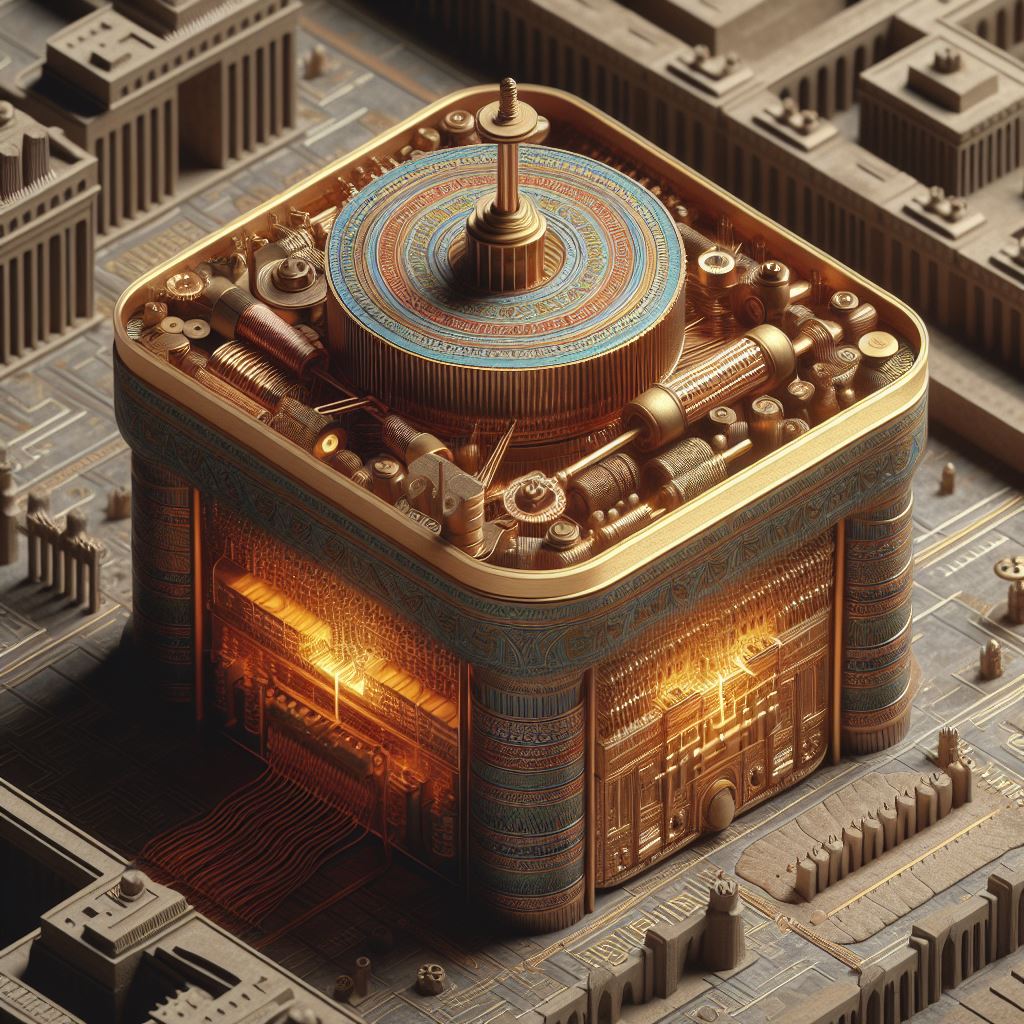Table of Contents
Ancient Indian Mystical Sci-Fi Tech: Fact or Mythic Fantasy?
Could nuclear weapons have annihilated cities in India ages before Hiroshima? Did gravity-defying Vimana flying chariots with deadly energy beams rule ancient skies? What strange disasters or weapons wiped out the Indus Valley civilization? Modern India’s foundations hide cryptic techno secrets that seem fantastical, yet tantalize explorers with clues defying the conventional history of science.
This expedition traversing mystical ruins and ephemeral texts will analyse remarkable anomalies that challenge what we assume possible from early societies. They force us to wonder how advanced in reality were cultures like Egypt, Mesopotamia or the Indus Valley Civilization nearly 5,000 years ago. Did select ancient groups tap into sophisticated disciplines like atomic energy, aeronautics, electricity and computing over 2 to 5 millennia before such technology officially emerged?

While rewriting history attracts over-romantics, we will avoid sensationalism and examine evidence objectively. Diverse mainstream sceptics demand high-proof standards before accepting extraordinary implications that could collapse linear views of gradual technical innovation since the Industrial Revolution. But breakthrough discoveries continue cracking scientific origins timelines like the Antikythera Mechanism’s geared astronomy calculator from 100 BCE. So which astonishing claims around India’s past pass skeptical muster best? Let’s embark on this expedition scrutinizing her mysteries. Buckle up!
Ancient Indian Technology: Nuclear Weapons in Mohenjo Daro?
The ruins of the ancient Indus Valley city of Mohenjo Daro hold a terrifying secret that has puzzled historians and archaeologists for decades. When the ancient site was first excavated in the 1920s, a staggering discovery came to light – dozens of skeletons scattered in the streets, many holding hands with their faces turned towards the sky.
These dramatic remains sparked speculation and debate about what catastrophic event could have wiped out the entire population of the city. New evidence of high radiation levels and glassy rocks pointed to a theory even more chilling – that these people were the first recorded victims of nuclear warfare, killed by an atomic blast from the sky over 2 millennia before the creation of the first nuclear bombs.

This sensational proposition continues to be one of the enduring scientific mysteries in Indian history. Modern technology has allowed new investigations into the strange fate of Mohenjo Daro’s people. While the idea of nuclear explosions in ancient India seems far-fetched, the mounting clues lend some credibility to the possibility of the world’s first nuclear attack. We will analyze the trail of evidence uncovered and explanations put forward by experts to determine how plausible the nuclear weapon theory could be.
The discovery of Mohenjo Daro itself was an archaeological revelation when excavations began in the 1920s led by Kashinath Narayan Dikshit. The elaborately planned city with advanced drainage and water systems pointed to an astonishingly sophisticated civilization nearly 4,500 years ago in the Indus River basin. But when populated areas were uncovered, the excavators were confronted by a post-apocalyptic vision of destruction instead of gaining insight into daily life. Scattered human remains lay strewn in streets and houses, many contorted into unnatural poses.
Strangest of all, skeletons were clustered together as if the mass of people were killed suddenly in these death poses while attempting to flee some cataclysmic event. The absence of domestic animals or precious possessions ruled out invading armies. Baffled by the unknown forces that devastated the entire population in an instant, excavation leader R.E.M Wheeler famously dubbed Mohenjo Daro “the city of death.”
Initial theories about natural disasters like flooding did not match the evidence. However, when later scientific analysis detected uncommonly high radiation at the site, as well as stones fused into glass-like chunks, parallels were drawn with the aftermath of modern atomic explosions like Hiroshima and Nagasaki. This led several researchers to put forward the shocking hypothesis that nuclear weapons were used during the Indus Valley era, instantly wiping Mohenjo Daro off the map.

While scrutinized by critics, the nuclear theory refuses to fade away even after decades of analysis. We will unpack the trail of clues and weigh the explanations offered by sceptics versus proponents of the idea that the ancients wielded destructive technology matching our modern capabilities. Excavations continue to unearth evidence from Mohenjo Daro’s ruins, bringing us closer to definitively solving the mystery behind this haunting monument to an extinguished civilization. The nuclear question persists as the enigma of India’s “city of the dead” endures.
Ancient Indian Technology: Traveling in Vimana Flying Machines?
Could space-age-like contraptions with aerodynamic designs and propulsion systems have hurtled through the skies of ancient India? Suppose thousands of religious manuscripts are to be believed. In that case, the fantastical “vimanas” – mythical flying palaces or chariots described in Sanskrit epics – represent real vehicles engineered to transport gods and royalty across vast distances and even into space.
These fanciful stories tend to be dismissed as creative myth-making by today’s historians and scientists. But a scattering of clues has sustained some theories that vimana flying machines may have been an exotic but replicable technology far ahead of other civilizations at the time. From pyramidal Aeronautics models based on vimana details spelt out in Hindu Sanskrit texts to contemporaneous sightings of mysterious aircraft from across the world, the secrets behind these purported aeronautic wonders of ancient India still court occasional debate in the fringes of mainstream academia.
The current basis for any scientific discussion around vimanas comes mainly from writings in the Samarangana Sutradhara, an 11th-century Sanskrit treatise covering a wide range of technical topics. A section called the Vaimānika Prakarana outlines everything from construction materials, engines and pilots to steering and propulsion methods for over 100 varieties of aircraft. They vary from small ramjet-fueled fighters to colossal carrier ships capable of hauling hundreds of passengers. Some even came equipped with weapons systems eerily foreshadowing modern warfare from toxic gases to lasers and biological agents.

Clearly, these documents describe imaginative, advanced concepts around aviation. But could there be truth behind the vimanas beyond creative artistry? A series of strange eyewitness accounts spanning many centuries seem to report similar aircraft in the skies from China and Egypt to Rome and medieval Ireland, variously called sky boats, cloud ships or flying shields depending on the era. Even Christopher Columbus and Sir Francis Drake both documented mystifying phosphorescent lights or fast-moving vehicles in the oceans and skies during their separate seafaring voyages.
In recent history, a series of attempts have gone into actually constructing vimanas using the design specifications described in Hindu epics. Sanskrit scholar Shivkar Bapuji Talpade claimed to have successfully flown India’s first unmanned plane in 1895, eight years before the Wright Brothers made history with manned flight. But failing to manoeuvre beyond short hops, these experimental models have yet to demonstrate the kind of fantastic long-distance flights or weapon-based dogfights outlined millennia ago.
Could the vimanas simply be fantastical inventions capturing the imaginations of accomplished ancient writers? Or was there a true aeronautical genius who mastered the mechanics of flight long before modern science caught up? The evidence remains thin but continues to intrigue those seeking hidden knowledge in Hinduism’s esoteric texts. We will survey the scattered pieces of this puzzle to determine if vimanas as functioning flying machines were a myth or an aerospace miracle erased by time.
Ancient Indian Technology: Anti-Gravity Lifting in Pyramids and Temples?
Marvelling at the construction feats of ancient wonders like the Great Pyramids and Angor Wat, modern engineers scratch their heads wondering how such massive stone structures were built with primitive tools and methods. Some theorize that the secret lies not in newfound mechanical leverage techniques but in manipulating gravity itself. Were anti-gravity devices used thousands of years ago to effortlessly lift and position 80-ton blocks for Egypt’s monuments and stone temples across South America and Asia?
Intriguing experiments and scattered anomalous discoveries have sustained serious interest in the idea that ancients could negate gravity’s effects through acoustic methods to hoist and align their grand edifices with laser-like precision. Modern concepts around “acoustic levitation” and related vibration-based techniques have reinforced the possibility that powerful sound frequencies were used to counteract gravitational forces on megalithic blocks before gently floating them into perfectly stacked arrangements.

Many Hindu temples and Egyptian necropolises feature peculiar staff head carvings near the corners and edges of the largest stone ceilings and architraves. In terms of function, they mimic the exact shape and placement of modern tuning forks used today to emit targeted sound waves, including infrasound frequencies below 20 Hz which can vibrate and dislodge massive objects. Could these ornamental temple carvings represent structural tools in plain sight that allowed anti-gravitic manoeuvres?
The key principles behind auditory-induced weightlessness continue to be proven on smaller scales using acoustic resonances or other resonant canvases harnessing energy from within pyramidal and concave structures. In fact, during the 1980s, acoustic chamber experiments conducted by engineer Eugene Podkletnov yielded unexpected gravity-shielding phenomena. Objects hovering over vibrating superconductors started losing up to 2% of their weight when stimulated with specific electromagnetic fields.

While a slim gravitational effect, it still represented a measurable influence in altering an object’s buoyancy. Angular sculptures resonating sound waves that modify gravity enough to lift giant blocks therefore do not seem so far-fetched. Sceptics point to a lack of hard evidence that such anti-gravity applications were put to use in the ancient world. But others believe we are barely scratching the surface of rediscovering acoustic solutions engineered by early temple builders to manipulate gravity fields and construct their breathtaking stone tapestries found across the ancient world.
Ancient Indian Technology: Complex Analog Computers for Tracking the Heavens?
A chance discovery made by sponge divers plunging into Mediterranean depths in 1901 revealed technology thought impossible for ancient seafaring cultures. Pulled from the wreckage of a 1st-century cargo ship off the Greek island Antikythera, a perplexing clockwork device resembling a complex gear mechanism would ultimately be dubbed the world’s oldest analogue computer.
Found crushed among plundered treasures like exquisite marble and bronze statues, the mechanism confounded early archaeologists. X-ray analysis later unveiled an intricate system of dials, gears and cogs used to mathematically predict precise positions and movements of celestial objects like the sun, moon and planets visible to the naked eye.

Rather than a navigational astrolabe as first suspected, researchers concluded 30 corroded precision gears worked together as a stunningly advanced astronomical calculator tracking eclipse cycles, zodiac signs and solstice or equinox transitions using input knobs and a hand crank. All while outputting this astrological data through displays on the calculator’s faceplate.
By turning a single key, the Antikythera Mechanism modelled the heavens into the future decades ahead as a compact pocket-sized planetarium scripting the rhythms of the cosmos over 2000 years before modern science could conceive of such accuracy.
The ingenious engineering suddenly made sense of certain anomalous classical references to mechanized planetary prediction systems described by ancient scholars like Cicero and Posidonius. Could other lost relics like Syria’s silver Apollo Box have integrated similar gear-driven movements to function as scientists theorize?
While it raises tantalizing ideas, most antiquities experts caution against overstating the importance of the Antikythera find as hard evidence of widespread advanced technology in the ancient Mediterranean world. Likely created by Greek astronomers, the one-of-a-kind device probably represented an artisanal showpiece demonstrating theoretical celestial knowledge rather than everyday widespread use. The craftsmanship of its quality indicated an elite expensive instrument reserved for the upper ruling classes.

No factories churned out such intricate hand-cut differential gear sets with the level of precision machining found in the Mechanism. And given the isolated single intact discovery, historians doubt any systematic transfers of skills or engineering schools spread this level of technical sophistication substantially beyond one or two intellectual circles designing eclectically geared demonstration objects under wealthy patronages before the know-how faded away.
So while expanding boundaries for ingenuity in analog computing applied to tracking heavenly bodies using complex gear ratios and pin-and-slot mechanisms, our sample size of one remarkable Antikythera Mechanism does not provide enough evidence to classify ancient Greek engineering capabilities as fundamentally superior to other old-world scientific traditions based solely on this unique surviving specimen. Nevertheless, it offers a rare tangible glimpse into ambitious techno-scientific frontiers being pursued over 23 centuries ago through exquisite bronze work.
Ancient Indian Technology: Strange Anomalies Carry Mysteries from the Past?
Several additional clues sprinkled through history books hint at advanced devices or inventions conceived in the ancient world that stretch our assumptions about prevailing technological limits over two millennia ago. While inconclusive in isolation, together they provoke us to broaden our horizons around earlier cultures mastering disciplines only recently considered modern breakthroughs.
For example, Hindu scripts dating back to the Vedas period before 500 BC accurately state an approximation for the speed of light as 2202 yojanas per half times, which converts to about 186,000 miles per second under current conversion tables. Rounding errors aside, verbatim textual reference to light’s velocity from the 7th century BC Sanskrit scholar Sayana that closely matches 1960s measurements seems jarringly anachronistic.
Other optical mysteries come from unexpected artefacts resembling precision-machined parts found within old Indian stepwell subterranean temples. On one occasion, British Indian army engineers discovered lens-shaped rock crystals tucked inside dark niche chambers absent of adornments, leading to whispers of ancient precursor telescopes qualifying as hi-tech by medieval standards when they were unearthed in the 19th century.

Meanwhile, further descendant mentions emerging from Islamic and Chinese accounts of Hindu sages projecting lifelike animated scenes onto mist clouds from afar for entertainment purposes. Described illusionist displays resemble modern laser-based holography cross-referenced by both cultures. And a final disorienting touchpoint – detailed technical diagrams of complex mechanisms resembling modern grinding machines integrated into the stonework friezes of several remote Jain and Hindu sanctuaries.
No doubt these peculiar references planted sporadically across centuries can be looked at critically as tenuous data points in isolation. But stacked together, the repeated instances of advanced optics, projection systems and mechanical drives being described or depicted begin forming an unusual pattern where the smoke of extraordinary claims starts to point to whispers of lost hi-tech fire.
As with vimanas, deconstructing physical evidence around such anomalies remains limited. But science prides itself on fact-finding missions exploring unexplained phenomena through rigorous inquiry rather than dismissive rigidity. As descendants of an ancient land still being understood, India may yet yield more residual clues to outside-the-box innovation predating modern assumptions on technological progress by unlocking additional mysteries from its long past.
Conclusion
India’s rich history offers glimpses into unexpected sophistication through clues that point to nuclear age weapons, functional flying machines, anti-gravitic magic tricks or analogue computers far beyond the accepted chronology of when advanced applied science was thought possible. While modern academic fields downplay such anomalistic evidence as conjectural or factually sparse, our journey surveying these thought-provoking mysteries reveals that the distant past can still surprise us.
Perhaps ancient world innovation has not revealed all her secrets yet across the sciences. With India’s living heritage still being unearthed, transdisciplinary wisdom focusing objectivity on both sides of extraordinary claims versus mainstream tenets can uncover further hidden gems still waiting patiently underneath the soil for their lost voice to finally be heard once more.
want to read more about Bhartiya history like the great Chola dynasty ETC. THEN PLEASE CLICK HERE
FAQS ON ANCIENT INDIAN TECHNOLOGY
What was ancient India’s technology?
Based on many texts and anomalies, there is some controversial evidence implying ancient India mastered advanced technology like rudimentary electricity, flight, and nuclear energy many centuries ahead of their emergence in the modern era. Most academics remain sceptical about the lack of mainstream physical proof. However, the possibilities continue to intrigue researchers.
Which technology was first developed in India?
Officially, India pioneered metallurgy, complex mathematics, meditation, organized cities, and intricate philosophy systems predating Europe’s Enlightenment era. Unofficially, scattered evidence suggests concepts like aviation, astronomy, optical sciences and alchemy emerged out of India thousands of years before their accepted histories. But substantiation of advanced ancient technology in India remains inconclusive.
How advanced was ancient India?
Ancient India showed advanced urban planning, medicine, philosophy, linguistics and intuitive sciences on par with any global civilization comparable to its time. Controversial texts indicate additional sequestered knowledge around theoretical physics, cognitive enhancements, anti-gravity and genetics existing amongst India’s historical elite that mainstream archaeology has yet to prove.
What items did ancient India invent?
Historical Indian inventions include cotton-spinning devices, meta instruments, distilled alcohol, rudimentary make-up, surgical devices like forceps and scalpels, and solid number systems with concepts of zero, pi and the mathematical constant e, ahead of similar developments worldwide. More extreme theories involve nuclear warheads, guided missile weaponry, self-powering generators and mercury-fueled spacecraft – none yet conclusively evidenced.
Why are we only now discovering ancient Indian technology?
A tacit acknowledgement of advanced ideas exists encoded in Indian poetry and medieval Hindu temple artwork referencing machines, vehicle diagrams and electronics. However, colonialism suppressed the open study of achievements deemed inconsistent with language translations and imported historical assumptions of primitive Oriental cultures, creating today’s knowledge gaps that new archaeological techniques aim to close.
Did ancient India have nukes?
While traces of radiation found at Mohenjo Daro ruin sites point to a nuclear-type event ending the Indus Valley civilization, counter explanations around naturally occurring isotopes provide plausible alternatives to nuclear weapons. Clear proof of radioactive materials isolation and weaponization does not surface in ancient India. But Dwarka ruins also showcase vitrified stone resembling postwar atomic blast zones, further muddying the origins of this nuclear event theory.
What kind of technology did aeroplanes have in ancient India?
Sanskrit epics describe over 100 varieties of piloted aircraft called vimanas outfitted with advanced features including manipulation of time-space, stealth cloaking devices, heat-seeking missiles, mercury plasma engines and solar energy absorbers. However, testing functional models using available construction specifications has not delivered any flying prototypes exhibiting these capabilities to date. The only authentic ancient aeroplanes thus far discovered belong to the early paper kite and parachute variety rather than jet propulsion vimanas.




